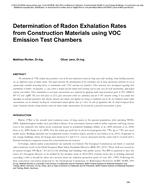Description
The inhalation of 222Rn (radon) decay products is one of the most important reasons for lung cancer after smoking. Stony building materials are an important source of indoor radon. This paper describes the determination of the exhalation rate of stony construction materials by use of commercially available measuring devices in combination with VOC emission test chambers. Three materials were investigated regarding their contribution to Indoor Air Quality, i.e. clay, which is widely used for indoor wall coverings and in some cases for wall constructions, light-weight concrete and clinker. Their contribution to real room concentrations was estimated by applying model room parameters given in ISO 16000-9, RP 112 and AgBB. The tests took place in 22 L glass desiccators which are commonly used for VOC emission testing. It was found that depending on material parameters like density, porosity and volume and applied air change or ventilation rate in the test chambers indoor radon concentrations can be obtained reaching the recommended annual effective dose of 1 mSv. In view of regulations like the draft European BasicSafety Standards directive setting reference values for indoor radon concentrations, the necessity for a practical test procedure is given.
Citation: IAQ Conference: IAQ 2013: Environmental Health in Low Energy Buildings
Product Details
- Published:
- 2013
- Number of Pages:
- 5
- File Size:
- 1 file , 1.7 MB
- Product Code(s):
- D-2013IAQConf-72




